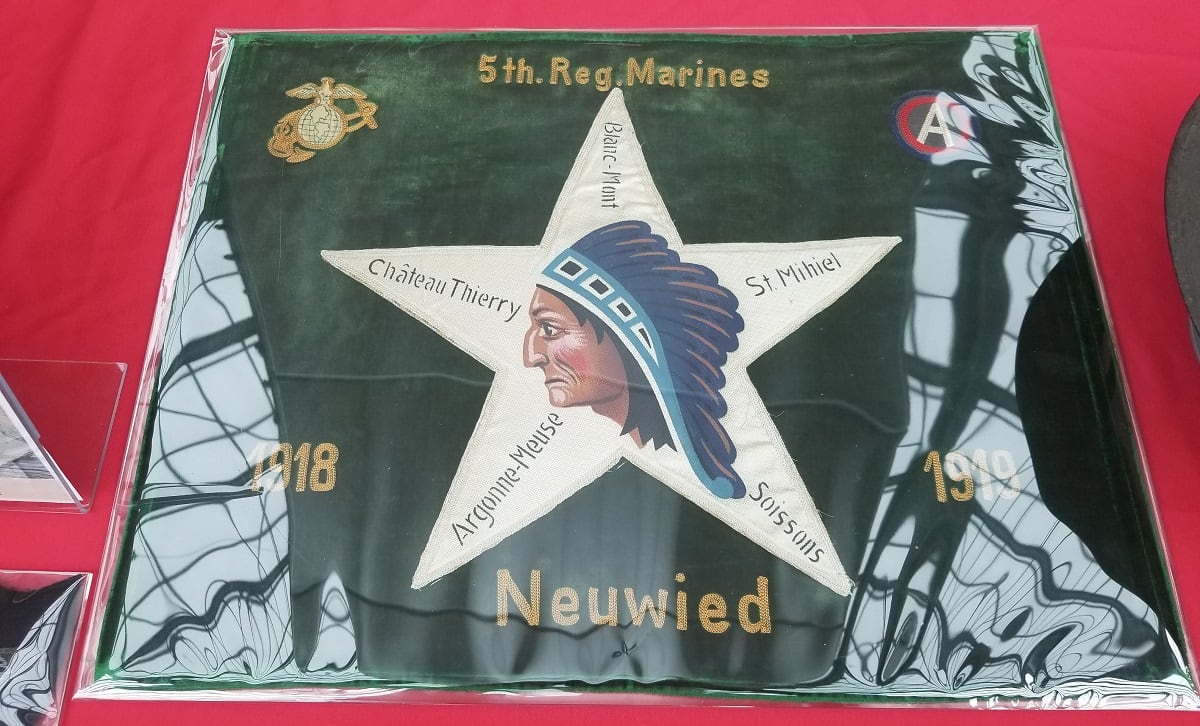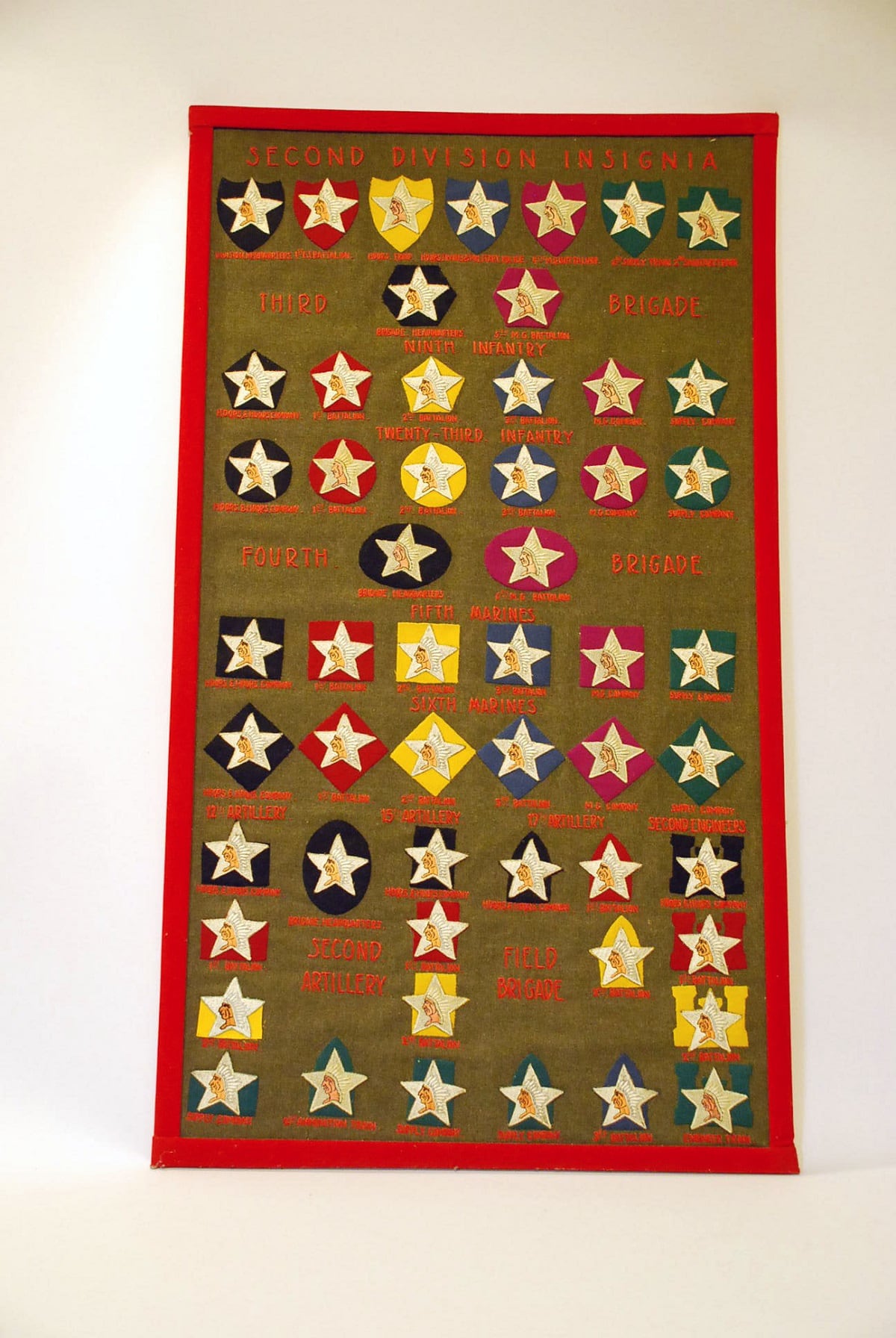For years in Afghanistan and Iraq, Marine special operators were hounded for sporting the iconic Raider patch on their camouflage utilities. However, the Corps actually has a short history of unit shoulder patches that starts in World War I with the beloved 13th commandant of the Marine Corps.
During one of the greatest wars in Europe, like the Army, the Marines wore shoulder unit patches, and amid all the fighting, the Corps had to weigh in on its design.
After World War II the Marine Corps revoked the practice, calling it an Army tradition foreign to the Corps.
Marine patches using American Indian imagery were recently put on display at an event hosted by the National Museum of the Marine Corps on April 25 in commemoration of the World War I centennial. June 1 will mark the 100-year anniversary of the Corps’ bloody battle at Belleau Wood in France.

The story of the Corps’ first shoulder unit patch is a strange one to say the least, and was borne out of the chaos and mass movement of troops to the Western front in World War I. The iconic American Indian head unit insignia eventually sported by Marines during the conflict had a tactical advantage, helping the Marines and the unit they served under, the 2nd Army division, move supplies to the correct units and destinations.
During the rancor of WWI, the sheer size of U.S. and foreign military units made it hard to distinguish which supplies went to what unit. It also made it difficult to distinguish individual commands.
The British eventually adopted a method of using various shapes like squares and diamonds sewn on the shoulders of their uniforms to distinguish units. Part of those designs found its way into American military patches.
“During World War I was the first time all the Army units were beginning to find a need for identification down to the unit level,” Owen Conner, a curator at the National Museum of the Marine Corps, told Marine Corps Times during a special exhibition of the Corps’ WWI unit patches on April 25.
The Corps itself had a relatively small footprint during the war. The 5th and 6th Marine Regiments served with the Army’s 2nd American Expeditionary Force division under the command of then-Marine Maj. Gen. John A. Lejeune. Lejeune would eventually go on to serve as the 13th commandant of the Marine Corps.
The unit shoulder patches worn by the Army and Marines were not approved until relatively late in the war, around November 1918 ― well after the Corps’ hallowed battle at Belleau Wood. Vehicles and trains carried the emblems as early as March 1918.
The design, the white star with an Indian head, was picked in contest that included Marines and Army with the 2nd Division. The Indian head was taken from the popular U.S.-minted Saint-Gaudens $20 gold coin.

“The star has played an important part in our history from the struggling days of the colonies to the present time,” 1st Lt. Gordan H. Steele, an officer with the 2nd Division, wrote in 1921 in a document provided to Marine Corps Times by the National Museum of the Marine Corps.
“There is no need to remind any one of the significance of the Indian. He is the first, only true and original American,” Steele wrote.
Still, amid the death and destruction of World War I, then-Maj. Gen. Lejeune still had to weigh in on approving the shoulder worn insignia.
In a telegram to the commanding general of American Expeditionary Forces dated Oct. 21, 1918, Lejeune wrote, “The white star with Indian head painted in two colors has been used in the division for some time … [T]he plan for procuring designs are already under way, and it is urgently recommended that the design for insignia for the Second Division as submitted be approved and that approval be telegraphed at the earliest possible date, in order that there may be no delay in procuring and issuing insignia. It is desired, if possible, to have the insignia issued before the division goes into the line again.”
The insignia was approved just a couple weeks later on Nov. 6, 1918. But the war ended shortly thereafter, on Nov. 11, 1918.
Uniform patches across the Corps would be relatively short-lived.
The Corps ended the practice shortly after World War I and restarted it in World War II. The shoulder unit insignia was not very widespread and only worn by 33 units during the Second Great War.
“Soldiers of the sea, Marines with patches,” World War I was just a weird time for the Corps, according to Conner. “They didn’t necessarily mind being called soldiers at that time.”
World War I heralded the birth of the modern Marine Corps as we know it today, Conner said. But during that time there were a lot of growing pains and new traditions that were birthed.
Patches made a comeback in the Corps in World War II, but the practice was ended in 1946.
In a memo dated April 29, 1946, from the Headquarters Marine Corps to the commandant, the Corps stated, “The use of shoulder patches is a custom alien to the traditions of the Marine Corps, and its adoption in both cases was based on Army precedent.”
“Because of the comparatively small size of the Marine Corps, it is undesirable to maintain in existence unnecessary distinction between the type of duty to which an individual is assigned, particularly from the point of view of esprit de corps,” the memo reads.
It further states that shoulder insignia can foster both pride and prejudice.
The shoulder insignia in World War I primarily was worn in post-war victory parades, not on combat uniforms.
Shawn Snow is the senior reporter for Marine Corps Times and a Marine Corps veteran.




